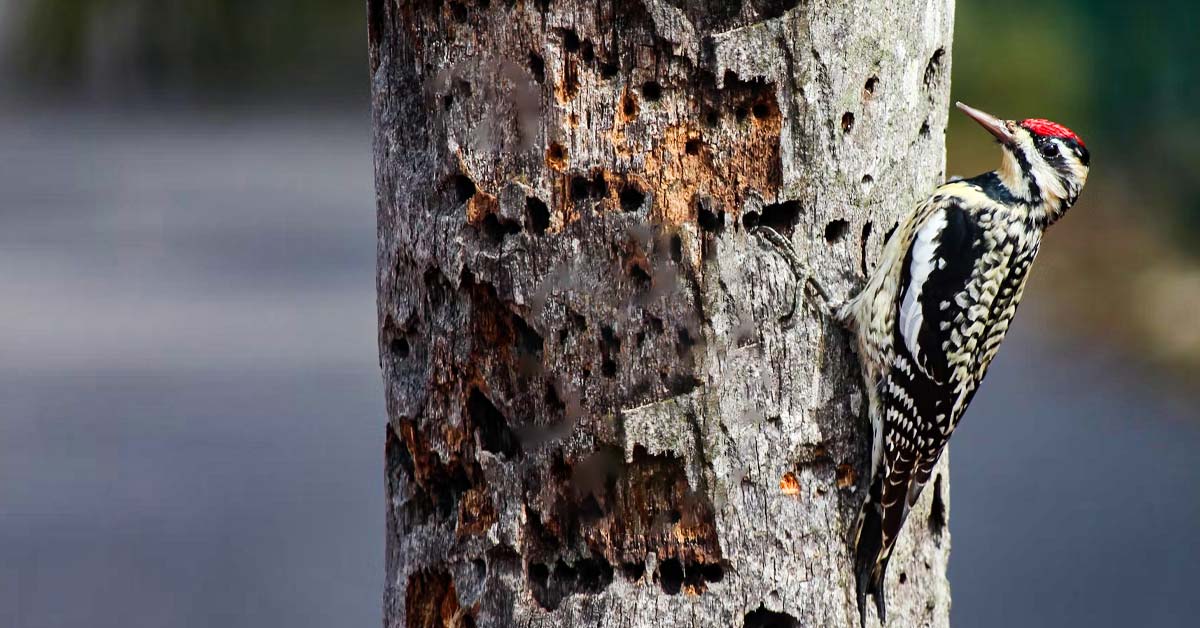There are 10 known species of woodpeckers in Arkansas, 7 of which are easily found in forests to this day, and the other 3 species are considered rare or almost extinct.
Woodpeckers (and other 350+ species of birds) love Arkansas because of the state’s mild climate, over 600,000 acres of natural lakes, and lush wilderness.
If you’re on a mission to see woodpeckers in Arkansas up close, bird-watching in one of the state’s parks is the way to go.
7 Common Species of Woodpeckers in Arkansas
So you decided to visit Arkansas and go bird-watching for woodpeckers. What kinds of woodpeckers are in Arkansas? How do you identify the type of woodpeckers you’ll come face-to-face with?
If you live in AK, how do you encourage these woodpeckers to visit your yard?
Here are 10 woodpeckers found in Arkansas, the sounds they make, and the specific characteristics of each type of bird:
1. Northern Flicker (Colaptes auratus)
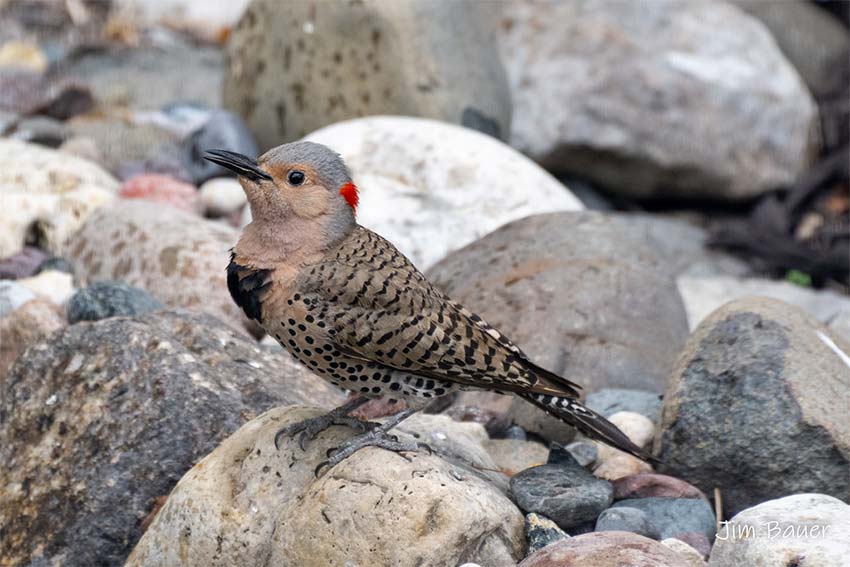
Beginner birders who visit Arkansas for woodpecker watching have the biggest chance of seeing a Northern Flicker. They’re very common in these parts of the country.
Where to find Northern Flicker in Arkansas:
Northern flickers have one of the biggest populations of woodpeckers in Arkansas, mainly because they live here all year round. Other Northern flickers from Canada or Alaska migrate to warmer places during winter.
You can find Northern Flickers in open habitats near trees, such as parks, cemeteries and even residential areas in Arkansas.
Appearance: How to spot Northern Flickers
Northern flickers are large birds. Babies, males, and females all have different physical characteristics depending on where they live, but they could grow about 30 to 35 cm long, 4 to 7 ounces heavy and with a wingspan of 54.1 cm.
Northern flickers are overall grayish brown in color with black spots on their backs and on their chests.
In Arkansas and other eastern US states, these woodpeckers have yellow or red tails and underside of their wings with bright white feathers around the rump (which are mostly visible when they’re in flight).
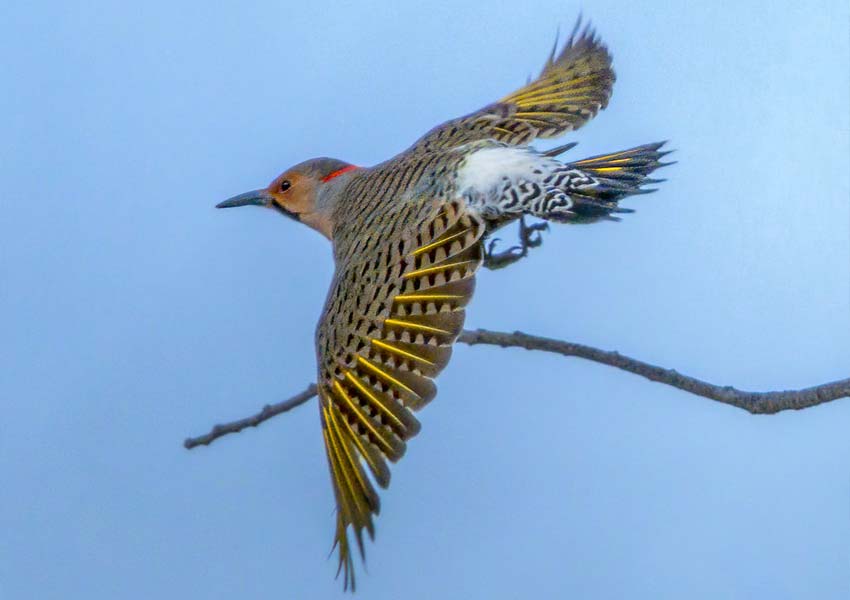
Northern Flicker Sound
The Northern Flickers sound is quite distinct, especially if you’re near one during the spring mating season (around spring to early summer).
Diet: What do Northern Flickers eat?
Unlike other woodpeckers that hunt for food in trees, Northern flickers dig through the ground and look for ants, beetles, termites, caterpillars, and other insects.
2. Pileated Woodpecker (Dryocopus pileatus)

Many people flock to Arkansas to get a view of these awesome-looking Pileated Woodpeckers. They’re a protective species, so keep your distance and take a harmless approach when taking photos or videos.
Where to Find Pileated Woodpeckers in Arkansas
The pileated woodpecker lives in Arkansas year-round.
They can be found in old woodlands and forests where there are downed logs and dead trees.
They can also be found in golf courses, parks, and backyards in both rural and suburban areas.
Pileated woodpeckers do not migrate. They stay in a particular town or state their whole lives. The only reason they move is if they deem their existing nest unsafe for their eggs.
Appearance: How to Spot Pileated Woodpeckers
Pileated woodpeckers are comparable to the size of a crow, but because of their bright red crest contrasting their black and white striped backs, you can’t mistake them for a crow.
Males may sometimes have a red stripe on the side of their faces.
Adults can weigh 8 to 13 ounces and grow up to 40 to 50 cm long with a wingspan of 70 cm on average.
The pileated woodpecker is one of the largest woodpeckers in Arkansas. It is extremely striking when you see one in person. If you know what the cartoon Woody Woodpecker looked like, you’ll recognize that the animator may have based him on this bird species.
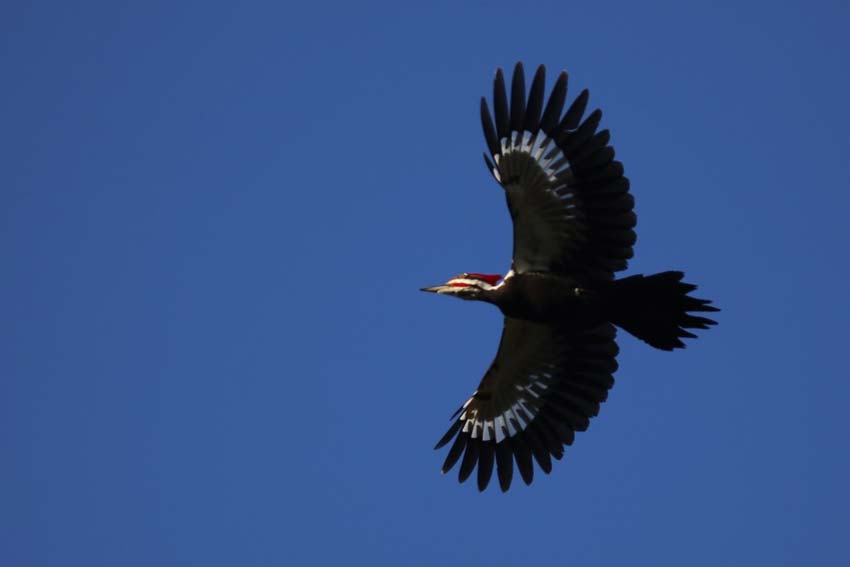
Pileated Woodpecker Sound
Because pileated woodpeckers are big in size, their drumming sounds can be loud as well. The drumming consists of 10 to 30 taps within 1 second.
You’ll be able to hear them drum year-round, regardless of gender, since they do this to attract mates or establish territory.
Diet: What do Pileated Woodpeckers Eat?
Pileated woodpeckers drum on dead trees and the ground for insects, larvae, and their favorite carpenter ants.
They sometimes eat berries and nuts, then stick their hunt to the trees.
3. Hairy Woodpecker
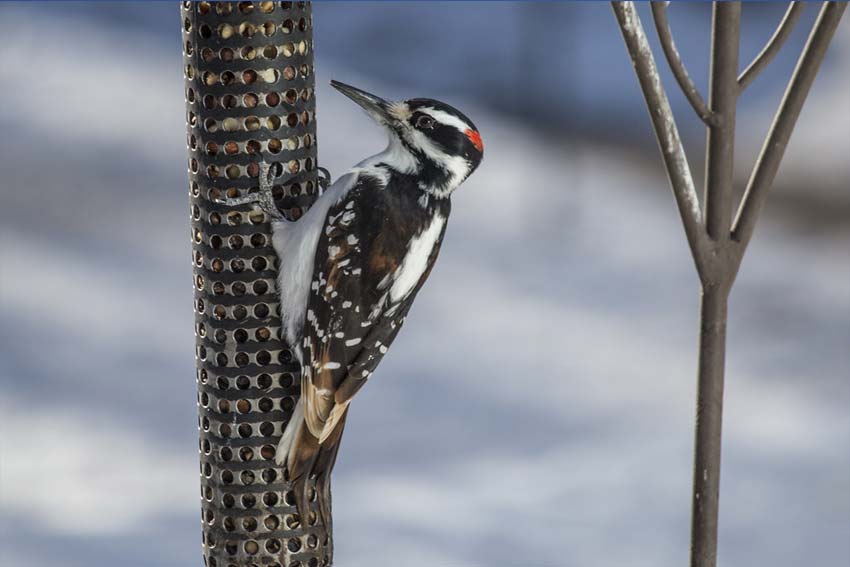
Hairy woodpeckers are named as such because of the long, thread-like white feathers running down the middle of their all-black backs.
Where to Find Hairy Woodpeckers in Arkansas
Hairy woodpeckers are not as common as Northern flickers, but their population is still present in most Arkansas parks, cemeteries, wooded suburban areas, and even in backyards with bird feeders.
Hairy woodpeckers do not migrate (even in colder seasons).
They stay in the same place, usually in dead trees where they can be found nesting. Your chances of seeing hairy woodpeckers increase during the winter season.
Appearance: How to spot Hairy Woodpeckers
Hairy woodpeckers are medium-sized birds with black and white feathers, pastel-colored bellies, and beaks as long as their heads.
They’re known to weigh up to 1 to 4 ounces and grow around 18 to 26 cm long with a wingspan of 35 cm on average.
You can tell their genders quickly because male hairy woodpeckers have a visible red spot on the nape (back of their heads).
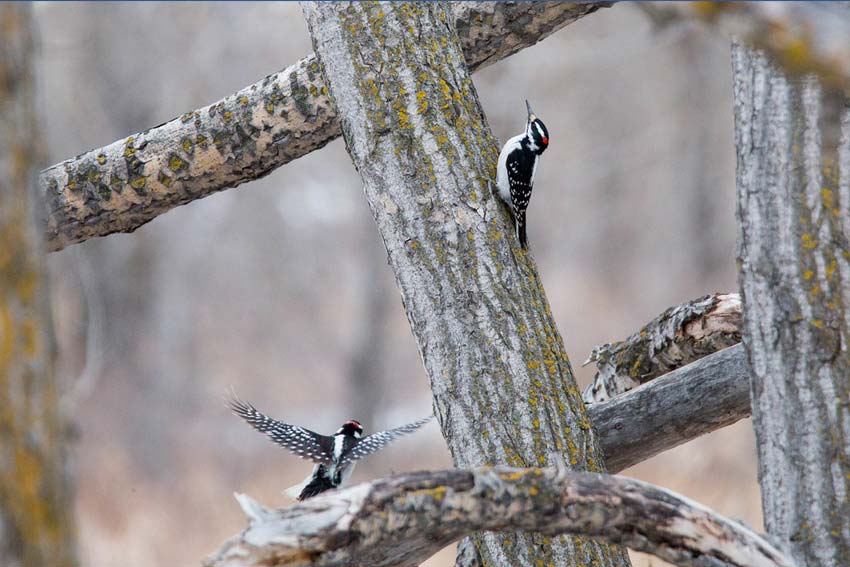
Hairy Woodpecker Sound
Both male and female hairy woodpeckers drum rapidly on trees year-round.
Male hairy woodpeckers have a uniquely sharp, high-frequency call that they use to warn others.
Diet: What do Hairy Woodpeckers Eat?
Hairy Woodpeckers love hunting for insects. Their diet consists mainly of ants and beetle larvae, but they also eat spiders, bees, or caterpillars.
4. Red-Headed Woodpecker (Melanerpes erythrocephalus)
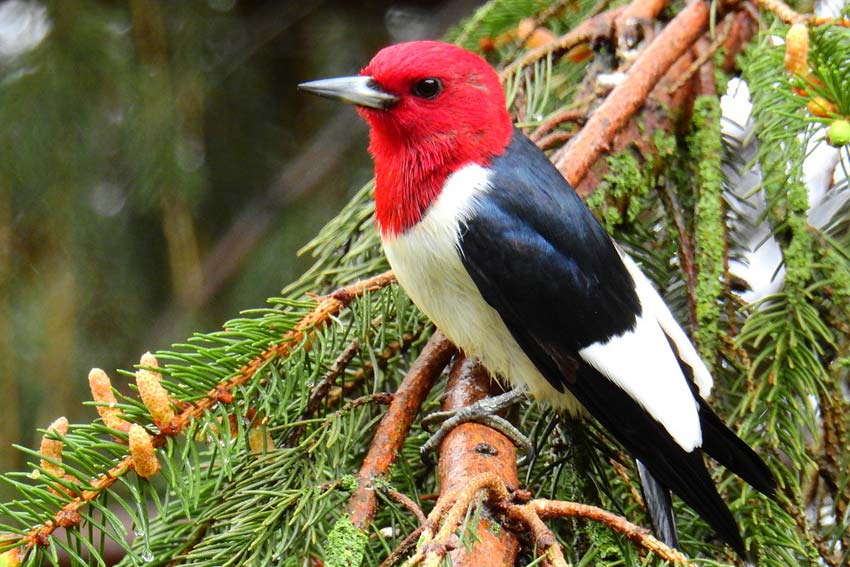
The Arkansas red-headed woodpecker isn’t as common as others on this list, but they’re still present around the state during both summer and winter months. Once you do get a rare sighting, you’ll agree that it is one of the most stunning woodpeckers of Arkansas.
Where to Find Red-Headed Woodpeckers in Arkansas
Red-headed woodpeckers live year-round in Arkansas.
While the population of these woodpeckers has drastically declined due to loss of habitat, they can still be seen visiting backyards, especially during the winter if you offer suet or citrus on birdfeeders.
You can find them living and nesting in woodlands, parks, orchards and other forests with dead trees.
Appearance: How to spot Red-Headed Woodpeckers
Young red-headed woodpeckers are dark brown to black with some white spots on their wings and pale red cheeks.
When they turn adults, their heads, necks, and napes all turn into dark velvety red, which contrasts perfectly with their solid-black wings and white underbellies.
Adult red-headed woodpeckers get as big as 2 to 3.5 ounces, 21 to 25 cm long and with a wingspan of 35 cm on average.
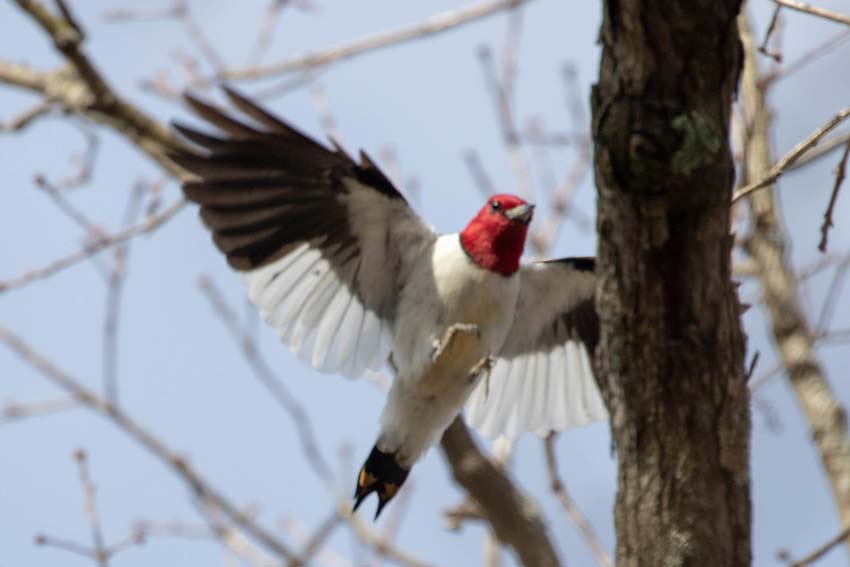
Red-Headed Woodpecker Sound
Red-Headed Woodpeckers give all kinds of calls from cackling to chirping, but they’re mostly known for their “shrill tchur” – a high-pitched call with less rolling.
Diet: What do Red-Headed Woodpeckers eat?
Red-headed woodpeckers look for nuts and seeds and stuff them in tree bark or holes for the winter.
They’re also known to catch insects as they fly, which isn’t a common woodpecker behavior.
5. Downy Woodpecker (Dryobates pubescens)
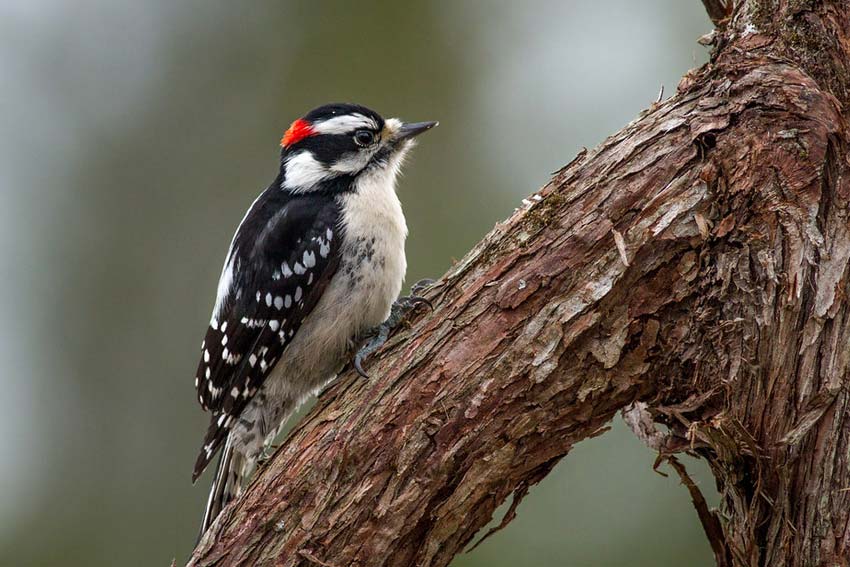
It may be the smallest woodpecker in Arkansas (and in the entire US), but they’re just as interesting as other Arkansas woodpeckers.
Where to Find Downy Woodpeckers in Arkansas
Like many woodpeckers in Arkansas who enjoy the year-round weather and do not migrate, Downy woodpeckers stick around the entire year even during winter.
They look for cavities of trees, where they live, and build their nests. Downy woodpeckers often fly around woodlands, groves, parks, and backyards – both in rural and urban Arkansas.
If you live in AK, hang a suet feeder in your yard during winter to attract them to your home.
Appearance: How to Spot Downy Woodpeckers
Downy woodpeckers have black and white feathers with a distinct white chest and dotted wings.
They look a lot like hairy woodpeckers, but downy woodpeckers are much smaller.
Adult males have red areas on their heads.
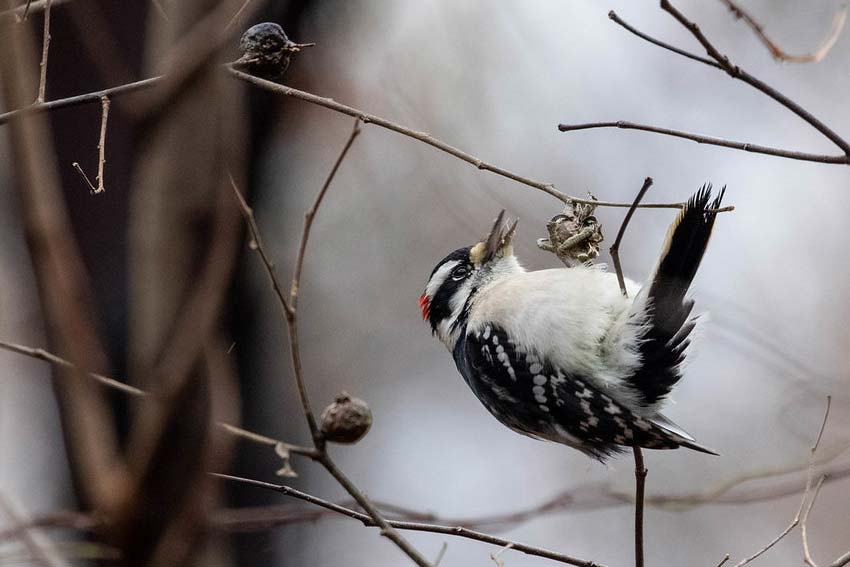
Downy Woodpecker Sound
Downy woodpeckers drum on trees extremely fast when establishing territory or looking for a mate.
Their calls are considered whinny and high-pitched.
Diet: What do Downy Woodpeckers eat?
They love eating peanuts, sunflower seeds, grains, berries, acorns and suet, but they also hunt for ants, caterpillars, beetle larvae, and other insects.
6. Yellow-Bellied Sapsucker (Sphyrapicus varius)
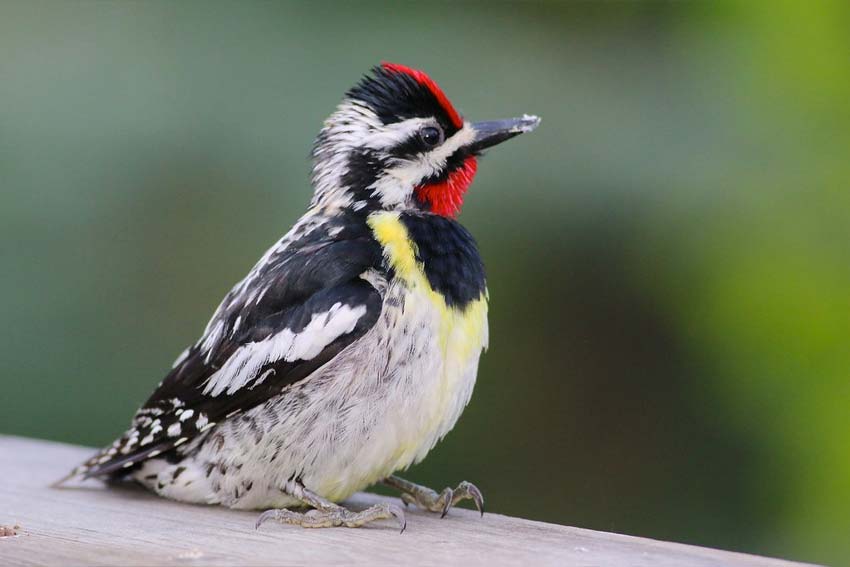
The Yellow-Bellied Sapsucker is small, but it is the most far-ranging of all woodpeckers you can see in Arkansas.
They’ve been found breeding across Canada from Coast to Coast, then return to Arkansas during winter.
Where to Find Yellow-Bellied Sapsuckers in Arkansas
Yellow-bellied sapsuckers live all throughout Arkansas during their non-breeding season.
They’re not as brave as other Arkansas woodpeckers, so they usually stick to high trees in the forests and rarely try their luck with backyard suet feeders.
Appearance: How to Spot Yellow-Bellied Sapsuckers
Yellow-bellied sapsuckers are medium-sized, black and white in color, and are identified mostly by the stripe on their shoulders.
Regardless of gender, these birds could grow up to 1.5 to 2 ounces, 20 cm long, and with a wingspan of 37 cm on average.
As its name suggests, these woodpeckers have a tinge of pale yellow underbellies.
In females, this yellow color isn’t as bright and their throats are white. The males have red throats and yellow or red foreheads.
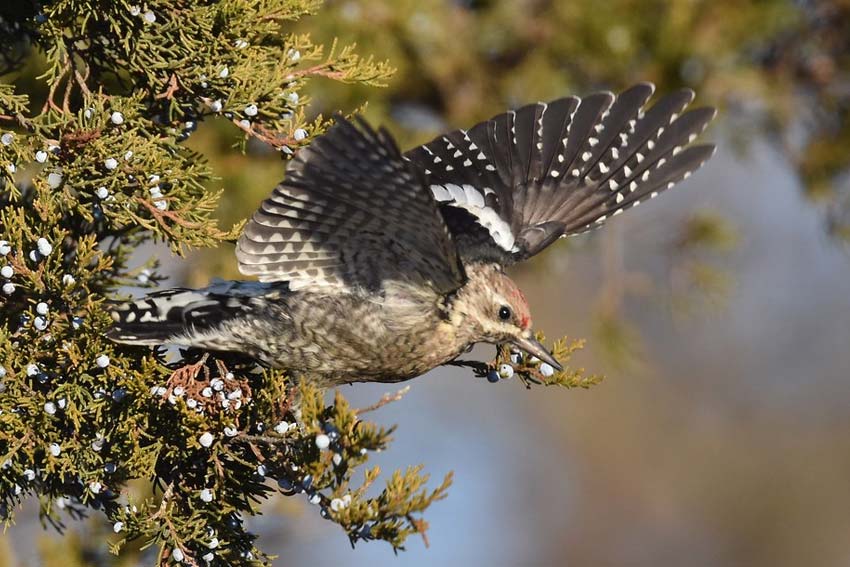
Yellow-Bellied Sapsucker Sound
Yellow-bellied Sapsuckers have a unique nasal mewing sound and a territorial, squealing, repetitive call heard usually in breeding season.
Diet: What do Yellow-Bellied Sapsuckers Eat?
The diet of Yellow-Bellied Sapsuckers consists of wild berries, fruits, flying insects, sap and sapwood.
7. Red-bellied Woodpecker (Melanerpes carolinus)
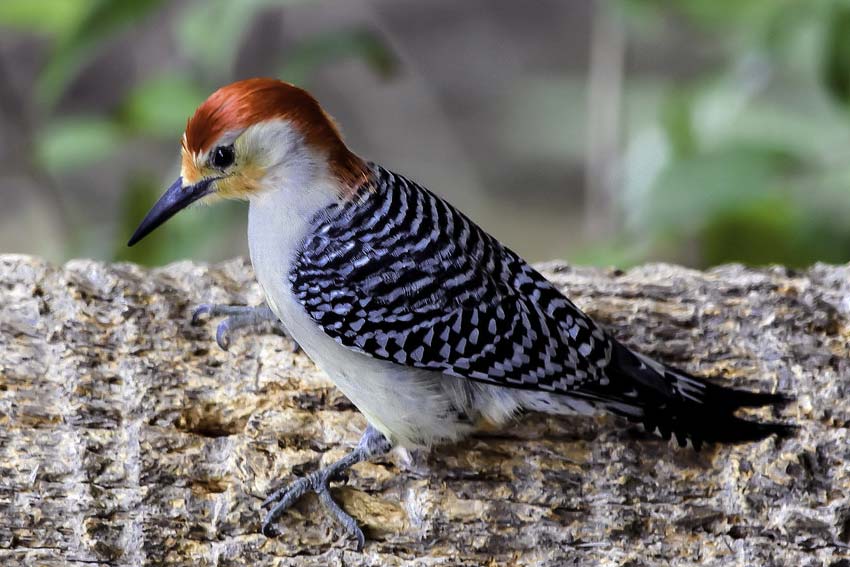
Red-bellied Woodpeckers are just medium in size, but the contrasting black and white striped backs and their bright red caps make them stand out in Arkansas forests.
Where to Find Red-bellied Woodpeckers in Arkansas
Red-Bellied Woodpeckers live in Arkansas all year-round.
They love nesting and drumming on oak and hickory trees or forested areas.
When they find a spot, they often return to the same tree each year.
Appearance: How to Spot Red-bellied Woodpeckers
Red-bellied Woodpeckers are often mistaken for the red-headed woodpeckers because of the similar red caps, but red-bellied are much smaller in size with (ironically) creamy white bellies instead of red.
Both males and females have black and white striped feathers and grow up to 2 to 3.2 ounces heavy, 22 to 27 cm long, and with a wingspan of 42 cm on average.
Females have a red nape, while males have a red nape and crown.
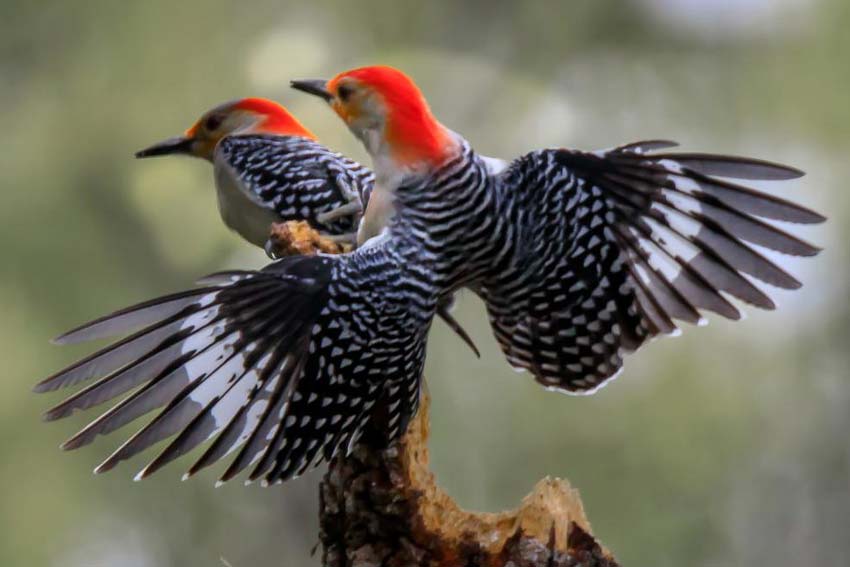
Red-bellied Woodpecker Sound
The drumming sound of red-bellied woodpeckers is often heard during the mating season between early winter and late spring. Males tap on the trees to attract mates.
Both male and female red-bellied woodpeckers have rolling “churr” or “kwirr” calls.
Diet: What do Red-bellied Woodpeckers eat?
Unlike other types of woodpeckers in Arkansas who love insects, red-bellied woodpeckers prefer fruits like wild berries.
3 Near-Extinct and Rare Woodpeckers in Arkansas
Unlike the 7 common types of woodpeckers in Arkansas above, the following species are considered rare and is in danger of becoming extinct.
8. Red-cockaded Woodpecker (Leuconotopicus borealis)
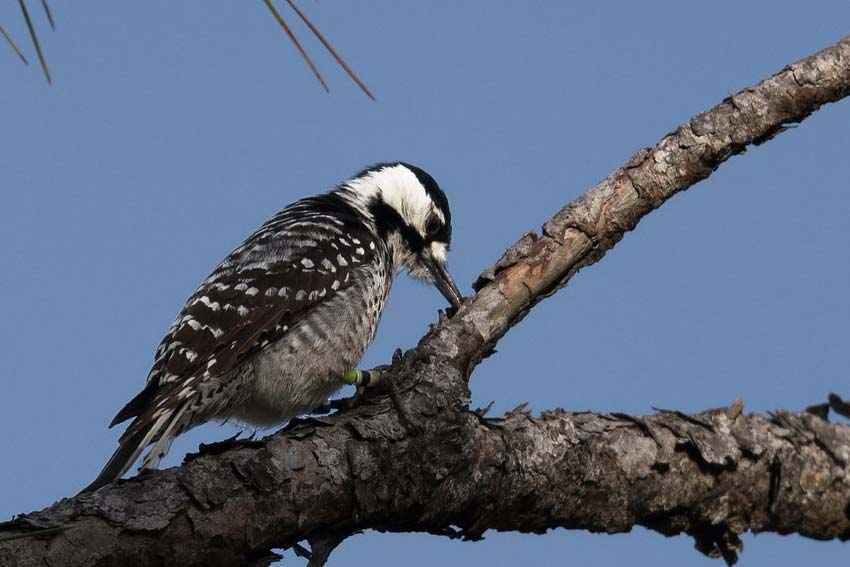
The Red-cockaded Woodpecker is the only woodpecker species on the Endangered Species List (they’ve been on this list since 1970 due to logging).
Most red-cockaded woodpeckers live in longleaf pines Arkansas. These areas are protected to insure these species thrive in the state.
These red-cockaded woodpeckers are medium-sized with black and white feathers, a black cap, black nape, and white facial feathers. Males are the only ones with red stripes on their cheeks.
These birds have a unique, raspy “sklit” call when they feel threatened or disturbed.
Their general call sounds like a typical churt.
9. Ivory-billed Woodpecker (Campephilus principalis)
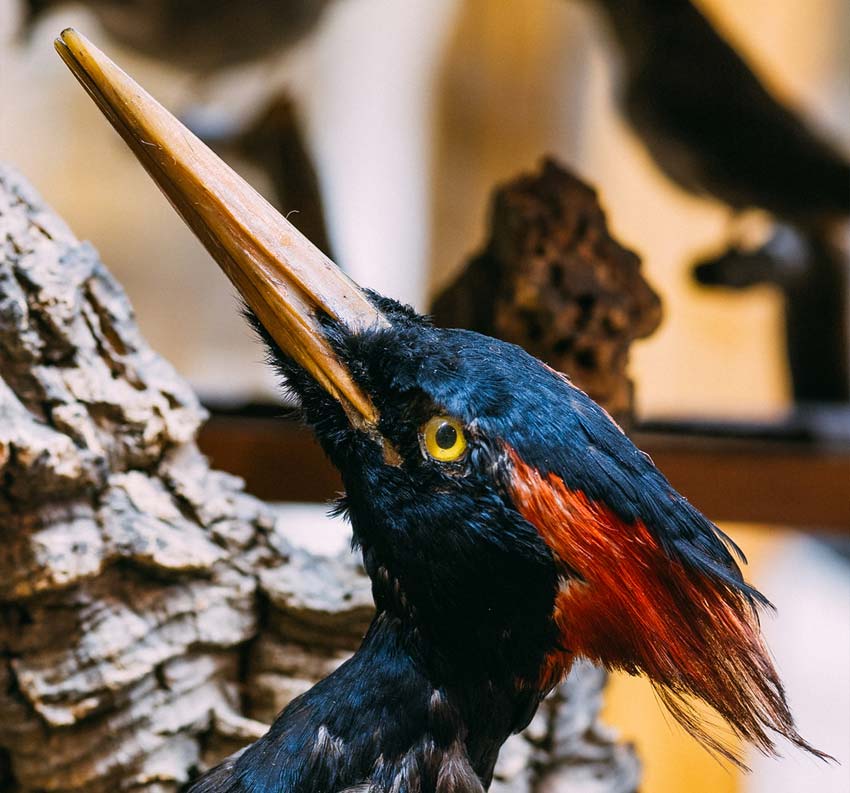
The Ivory-billed woodpecker is one of the most gorgeous woodpeckers in the world.
Unfortunately, it has been extinct since 1944 (when it was last seen in Louisiana).
But a 2015 sighting of the Ivory-billed woodpecker in eastern Arkansas has given hope to the bird-watching world.
Since then, many habitat restoration efforts and possible sightings have been made to support the evidence that ivory-billed woodpeckers continue to exist.
Some say the perceived sightings could just be a mistake and what they actually saw was the Pileated woodpeckers, which are also crow-sized and look almost identical to the ivory-billed woodpecker.
The only difference is that the ivory-billed has a thick white backpack, while the Pileated’s back is solid black.
As of July 2022, The U.S. Fish and Wildlife Service hasn’t closed the book on ivory-billed woodpeckers yet and have decided to extend its species status review until January 2023.
10. Lewis’ Woodpecker (Melanerpes lewis)
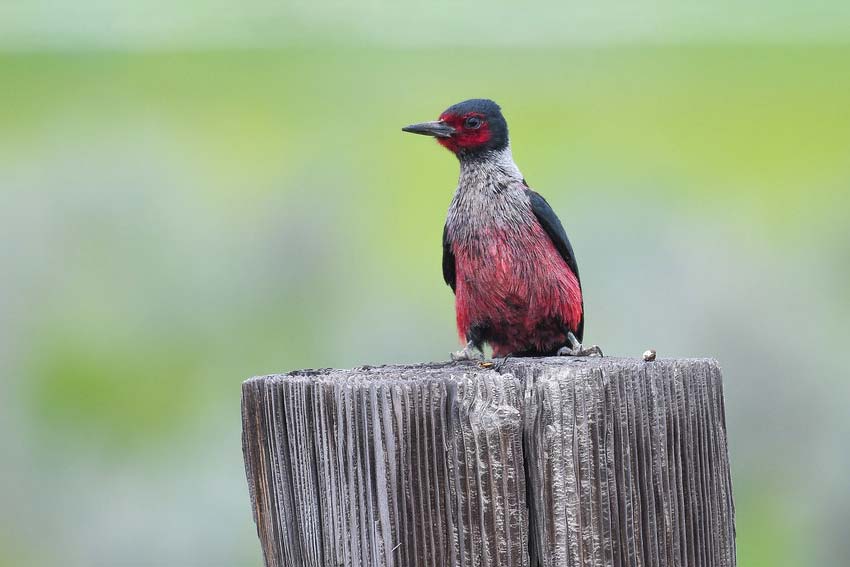
Lewis’s Woodpeckers are placed on the yellow watch list because of their declining population.
They are considered accidental or rare species in Arkansas, having been spotted in the state only 4 times in Mount Sequoyah.
Lewis’s Woodpecker look very dramatic with their black caps, red cheeks, black wings, grayish collar with a tinge of white feathers spread across the chest, then pinkish and red underbellies.
They’re one of the bigger woodpeckers of Arkansas with adults growing about 10.2 to 11.0 inches in length, 3.1 to 4.9 ounces in weight, and with a wingspan of 19.3 to 20.5 inches.
You can find Lewis’s Woodpeckers on pine, cottonwood, paper birch and any other dead or decaying trees. They rarely build their own nests – usually preferring to live on nests created by other woodpeckers.
So Many Woodpeckers in Arkansas
Who knew that Arkansas would be one of the best states to see woodpeckers?
I sure didn’t!
Keep an eye (and an ear out) for some of these beautiful birds. Maybe you’ll get lucky and spot an Ivory-Billed Woodpecker or one of the few Red-cockaded Woodpeckers left.
